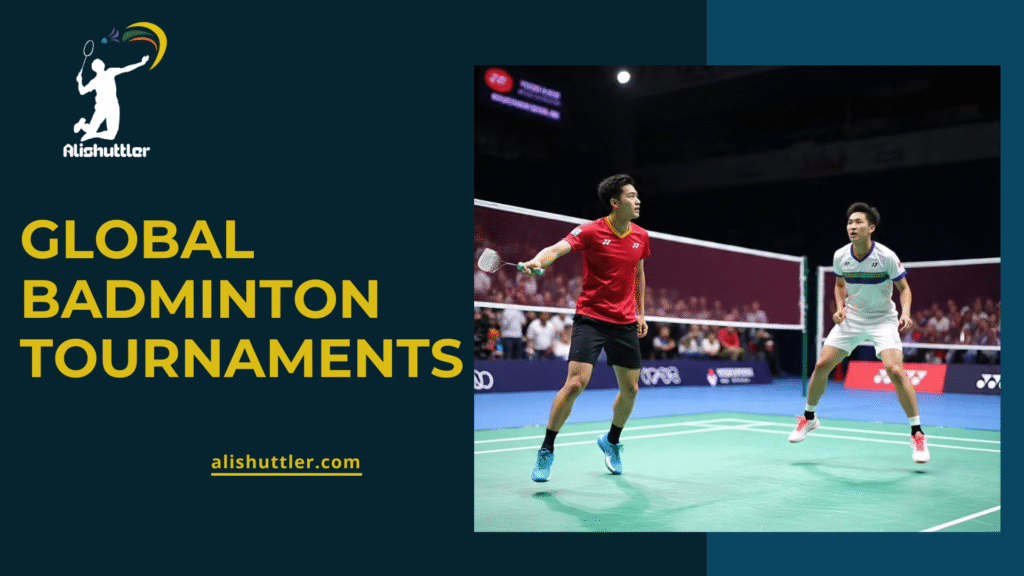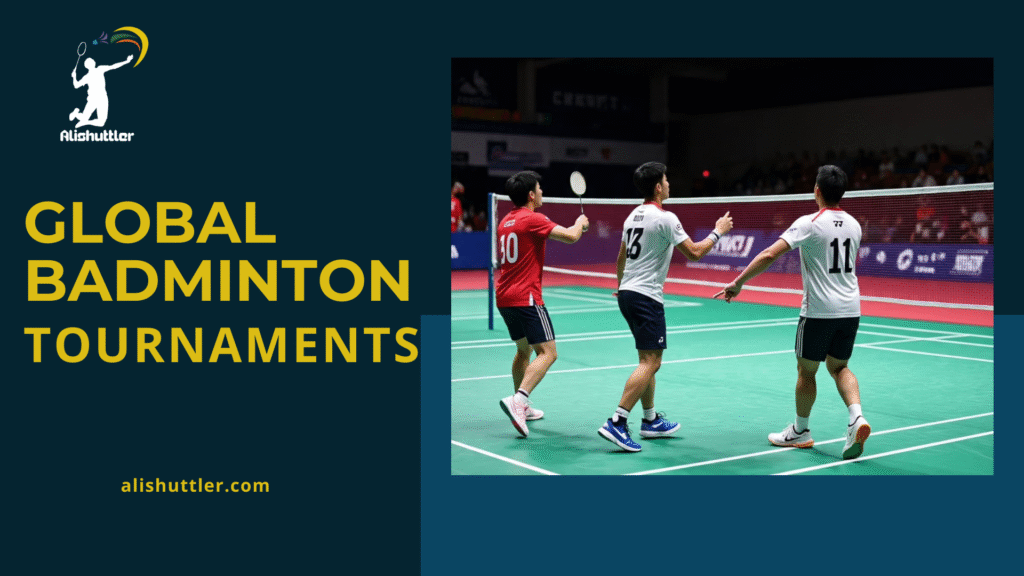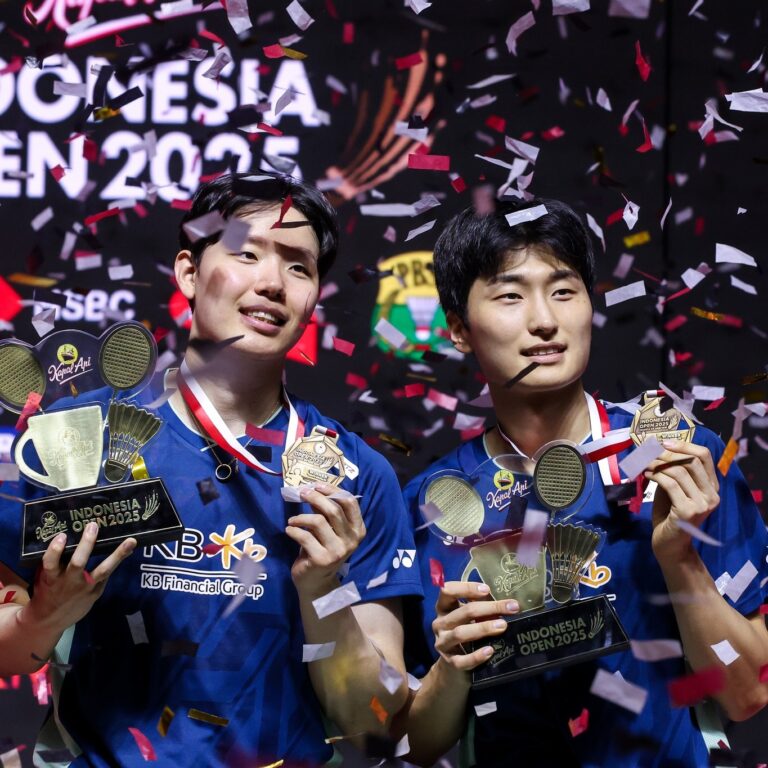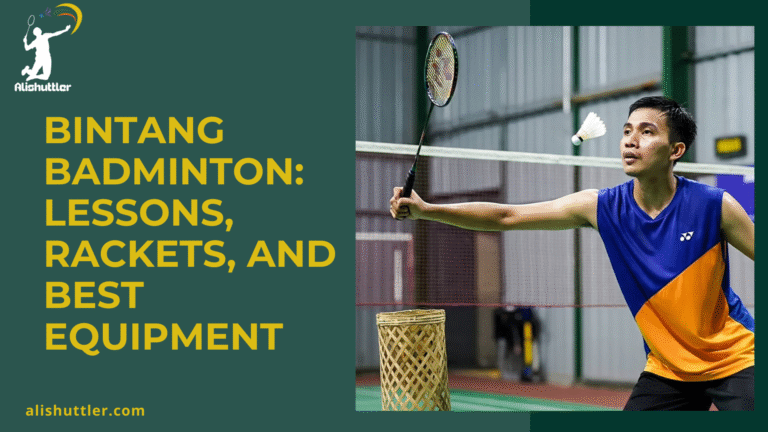Badminton tournaments and championships – where players and teams go head to head in local, national or global battles. These competitions attract players across regions, vying for supremacy. Some of them provide prize money or ranking points.
From amateur matches to world-class finals, these tournaments display technique and fair play. The following sections discuss categories, notable tournaments and how to participate.
The Tournament Hierarchy
Badminton tournaments have a distinct hierarchy each event carries its own significance. The major championships define the game, provide context for player rankings, and cement legacies. These events don’t just provide prestige; they define sports careers and national programs.

1. Olympic Games
Badminton became an Olympic sport in 1992, and it has been the pinnacle of the game ever since. An Olympic medal winner is more than just a one-person show an Olympic legend can become a national symbol. China, Indonesia and Denmark saw their players become household names following Olympic glory.
Certain finals, such as the 2008 men’s singles between Lin Dan and Lee Chong Wei, have become classics consuming millions. The Olympic spotlight has aided in putting Badminton Tournaments on the map for bigger audiences, increasing it in areas it previously had small footprints.
2. World Championships
The BWF World Championships, since 1977, is the most important singles/doubles event outside of the Olympics. Only the best players make it, and a world title is a career-defining moment. Legends like Lin Dan (five men’s singles titles) and Carolina Marin (three in women’s singles) are part of its history.
World Championships points are worth a ton in term of world ranking and often determine who ends the year on top of the sport. National federations commit resources to training and talent development for Badminton Tournaments with this event in mind.
3. World Tour Finals
World Tour Finals – featuring the top eight players or pairs in each discipline. Entry is based on points won during the season, so only those with consistent results make the cut. This is the pinnacle event of the year’s tour where the world’s best square off in a round-robin competition.
Previous victors such as Viktor Axelsen and Tai Tzu Ying have proven that impressive showings here can establish the rhythm for the following season. The Finals frequently act as an experimental crucible for rivalries and strategic adjustments.
4. Super 1000
Super 1000 tournaments — like the All England Open, Indonesia Open, and China Open — are the highest tier of the World Tour, below only the Finals. These events provide high purses and draw the strongest fields outside of the World Championships and Olympics.
High-performing players in Super 1000 events earn significant ranking points, frequently climbing the leaderboard swiftly. Champions such as Kento Momota and Chen Yufei have made their names with several Super 1000 victories.
The Super 1000 events are key milestones for players to qualify for the World Tour Finals.

5. Team Events
Team competitions – the Thomas Cup for men and Uber Cup for women see nations face off against each other in a combination of singles and doubles matches. The Sudirman Cup is a mixed gender event. These competitions operate on a knockout or round-robin system, with every tie challenging depth and collaboration.
When you play for a team, it ignites intense patriotism and solidarity. Teams generally employ rotating lineups, savvy matchups, or strategic rest periods to generate an advantage.
Youngsters frequently experience their first exposure to serious competition in these team Badminton Tournaments. National squads count on these Badminton Tournaments to gain experience and spot future stars.
Competition Formats
Badminton Tournaments employ various competition formats to organize equitable competition and structure player progression at every round. These formats determine more than just the matchups; they determine the tempo and rhythm of a championship.
The two most popular are single-elimination (knockout) and round-robin (group stage), each with their own rules and challenges for players. Defined, manageable formats are essential for equitable play and to keep bouts standardized globally.
Qualification
Qualifying for the big Badminton Tournaments is not for everyone. Players have to satisfy ranking criteria, occasionally determined by world or regional federations. Some have to triumph in smaller events or national qualifiers to gain entry.
Invitationals can select players based on previous performance. New players have terrible chances in qualifiers. They have to face much higher-ranked opponents, pay their own travel expenses, and have less fan support.
The road is rocky, as they have no experience and occasionally no access to quality coaching.
- Competing against more talented players early, resulting in premature elimination.
- Covering travel and lodging expenses without sponsorship.
- Juggling training with other life responsibilities, such as school or a job.
- Limited access to coaching, physiotherapy, or even proper equipment.
Seeding
Seeding orders star players prior to tournament draw. The idea is to keep top players from facing off in the early rounds, which serves to even out the competition and keeps the favorites around longer.
Seeding is based on world rankings or previous performance, and frequently shifts from event to event. To be seeded is to often receive a buttered slide through the early rounds, playing lower-seeded or less-experienced players first.
This can increase a player’s confidence and reduce premature exhaustion. Being unseeded means potentially brutal draws from day one.
There are upsets. At the 2021 All England Open, unseeded Lee Zii Jia upended seeds to leave a mark.
Knockout
The knockout format implies that a player is eliminated from the tournament after a single defeat. This is the case in nearly all major championships, such as the Olympics and World Championships.
Every match can be a do-or-die moment, making players sweat for the best possible efforts. Players are risk averse in early rounds but can shift tactics as the stakes increase.
They primarily prioritize rest, meticulous match scheduling, and psychological preparation. The pressure is intense, but so is the excitement.
- Upsets happen often, so favorites are never safe.
- Every match has high stakes, raising player focus.
- Fans get quick results and shifting storylines.
- The format can lead to unexpected finalists or champions.
Group Stage
Group stages allow contestants to face off in smaller groups prior to advancing to elimination rounds. Each player gets to play a few matches regardless of early losses.
This format is seen in team competitions such as the Thomas and Sudirman Cup, and certain individual championships. Players receive more exposure and an opportunity to adjust after an early loss.
Group stages help demonstrate a player’s consistency, since moving on requires strong results over a number of matches. Teams and players occasionally compete for point differentials, not only victories.
Others may sit top players if they’ve already clinched a berth in the next round. Here in the 2014 Thomas Cup group stage, Japan just barely defeated Denmark to set the stage for their first-ever Thomas Cup victory.

Dominant Nations
Dominant nations have differentiated themselves in world badminton for years, decades. These countries don’t just take home the greatest number of medals — they influence the sport’s fashions, training, and youth programs. Their advantage stems from a combination of robust grassroots infrastructures, popular backing, and emphasis on player development.
Asian nations — in particular China, Indonesia, Japan, S.Korea and Malaysia — dominate in wins at the top tournaments. Denmark emerges as the European highlight and the sole non-Asian nation to stand atop the podium time and again.
China had taken the lead in world titles since the late 20th century. The nation’s system begins training early, with state-sanctioned sports schools and an obvious route for talented athletes. Finances and support make athletes ascend from regional to national teams. China’s emphasis on both men’s and women’s events has resulted in a relatively even distribution of medals.
Indonesia and Malaysia, long time badminton strongholds, specialize in doubles and have an ardent fan base. In these nations, local clubs and schools constitute the cornerstone of talent spotting. Youngsters receive opportunities via regional leagues and national competitions, propelling them towards international play.
Denmark’s formula is rooted in club culture and accessibility. The Danish Badminton Association collaborates with thousands of local clubs to identify and nurture talent at a young age. The training is about skill, discipline and mental fortitude. The nation pours itself into coaches and provides players with abundant court-time.
Japan and South Korea grew fast in recent decades. Japan’s ascent is courtesy of school sports and private-firm patronage. South Korea’s strength is in doubles, with state and school programs emphasizing technical skill and teamwork.
Dominant nations provide infrastructure, consistent funding, expert coaching and defined progression routes from junior to pro. National organizations coordinate with local clubs, schools and sponsors to ensure players receive the necessary support to achieve elite performance. The secret is long-term planning and a culture that cherishes the sport.
Here is a table displaying some historical records and stand-out programs and players from these nations.
| Nation | World Titles (as of 2024) | Key Development Programs | Notable Players |
|---|---|---|---|
| China | Over 100 | State-run sports schools | Lin Dan, Chen Long, Li Xuerui |
| Indonesia | 60+ | Club-based talent spotting | Taufik Hidayat, Susi Susanti |
| Malaysia | 40+ | National junior leagues | Lee Chong Wei, Goh Liu Ying |
| Denmark | 30+ | Club and national training | Viktor Axelsen, Camilla Martin |
| Japan | 20+ | School-based programs | Kento Momota, Nozomi Okuhara |
| South Korea | 20+ | State and school integration | Lee Yong-dae, Kim Ji-hyun |
Evolution of Play
Badminton play has evolved a lot since then. Advancements in skill, equipment and techniques have influenced how players dribble and strategize on the court. Today’s play is quicker, more intricate, and frequently science and data-driven. Every change in the game originates from players across the globe infusing their own styles and concepts.
Technology
Technology molds badminton in various ways. Players and coaches do video analysis to look at footwork and strokes and reactions. Watching slow-mo clips, they verify mistakes and identify minor adjustments to optimize. This renders training more precise and assists teams to prepare for games.
Gear has evolved significantly. Today’s rackets are made from carbon fiber or graphite, which are lighter and stronger than the old wood frames. Feather shuttlecocks are expertly engineered to specific tolerances, so they fly truer and last longer. Shoes provide superior traction and support, enabling players to move swiftly without slipping.
Smart sensors monitor practice shot speed and racket angles, providing immediate feedback.
- Rackets: Shift from wood to carbon fiber allows faster swings and better control.
- Shuttlecocks: Consistent build quality gives truer flight and less wear.
- Shoes: Added grip and shock-absorbing soles protect joints and boost speed.
- Sensors: Built into rackets or shoes, these record swing paths, speeds, and footwork for instant review.
Strategy
Winning in badminton is a little more than just power or speed. Clever players employ numerous strategies—interspersing smash shots with gentle net play, varying pace, and inducing mistakes. Flexibility is crucial, as each game presents a fresh set of obstacles. Elite players might begin with a strategy but shift quickly if an adversary catches them off guard.
Researching competitors is so yesterday. A lot of players watch hours of old games, searching for tendencies or vulnerabilities. This allows them to modify their own play and anticipate surprises. Mind games count as well, particularly when the pressure is on. Solid concentration, cool nerves, and rapid wit frequently determine tight contests.
Training
Top players have regimented training schedules. Every day could have footwork, racket and reflex drills. Strength and conditioning are equally important, too — a strong body keeps players fast and less susceptible to injury. Recovery work, like stretching and rest, is incorporated as well.
Fitness builds stamina and strength, and coaching moulds skills and match sense. Coaches assist in simplifying complex moves into easy steps. They operate scrimmages to develop strategy, not merely brute ability. Mental training for Badminton Tournaments is a major emphasis as well. Top players learn to handle pressure and block out distractions — key in tense moments.
Behind The Scenes
There is more to running a badminton tournament than just on-court matches. So much goes on behind the scenes to make it all fair, smooth and safe for everyone. Every event is a team of experts, from organizers and sponsors to city officials and volunteers.
Planning begins months, sometimes years, before that initial shuttle strikes the ground.
Hosting
Host cities are chosen for a few things – a good airport, established public transit and a strong sports culture. Cities have to demonstrate they can manage crowds and provide players world-class venues to play and practice.
Major tournaments like the BWF World Championships or the All England Open frequently tend toward locations with sports pedigree — like Jakarta, Birmingham or Guangzhou.
Hosting generates revenue for local businesses and hotels, but it promotes Badminton Tournaments’ development in the city. The host has to partner with schools and clubs and reach out to the the media to get more engagement.
Certain host cities, such as Kuala Lumpur, have witnessed an actual surge in youth players enrolling in clubs after hosting major events there.
Logistics
Planning begins with a timeline. Organizers coordinate the dates and venues of matches, ensuring that courts, lights and audio equipment are available to world class standards.
Some are played in stadiums with seating for thousands, so crowd flow and safety are paramount issues. It’s hard work trying to coordinate schedules.
You have to squeeze in singles, doubles and mixed events all while allowing players rest time. Arenas need practice courts as well. For players and officials, simple transit from hotels to the arena is a necessity.
A lot of tournaments have shuttle buses or hire local drivers to simplify things. Good wi-fi and scoring systems help expedite the process.
Live updates, instant replays and online booking for tickets all need tech. Some events already utilize apps to keep players, coaches and fans updated on the action.
Sponsorship
Sponsors cover a large percentage of the expenses. Their cash goes towards such things as prize pools, publicity and hardware.
Global giants like Yonex and HSBC have had a long-standing association with the sport, emblazoning their logos on courts, shirts and banners. A nice sponsorship deal can really make a tournament.
It helps get Badminton Tournaments on TV and social media, exposing the sport to new fans. Some sponsors collaborate with elite players for commercials, benefiting both the brand and the athlete.
HSBC’s backing of the BWF World Tour is an exceptional example. Their dollars and distribution have elevated the tour’s profile and expanded its audience globally.
The Digital Court
Digital tech transforms how fans view and participate in badminton tournaments. Since the sport attracts fans from all over, digital venues allow even more to participate, regardless of geographic location. Sites such as YouTube and Facebook, along with event apps, now display live matches, post highlights, and share real-time stats.
Fans get more than just the matches – they receive player interviews, sneak peeks, and analytical insights. This wider access provides fans a more intimate pulse of the game while expanding its worldwide audience.
Social media is a huge factor in how events and players get noticed. Tournament organizers created official accounts on Instagram, X (formerly Twitter), TikTok, and Facebook. These pages publish match reminders, score updates, and compelling photos.
Players on their own profiles post practice drills, travel snapshots, and personal victories. This combination of the hard news and player narratives appeals to diehard fans and new audiences alike. For instance, when a top player shares a rally highlight, it can get to millions in hours, contributing to the sport trending online.
Streaming services tear down borders for world’s fans. A number of platforms such as BWF TV, DAZN, and regional sites have live and on-demand matches. So a fan in Europe can watch a tournament in Asia that day…live, with no replays needed.
Others overlay subtitles/multilanguage – making coverage easy for everyone to follow. The growth of mobile apps allows viewers to see games on their phones or tablets, so supporters won’t lose anything if they’re away. This move to streaming inflates figures for both large national titles and smaller local tournaments.
New digital initiatives strive to enhance it for all. Virtual reality trials let fans experience like they’re on the court, while augmented reality apps display live stats during games. Some organizers establish online fan zones, where fans can chat, participate in polls or join Q&As with players.
Digital ticketing and QR passes accelerate entry at venues and reduce paper waste. Big tournaments run fantasy leagues and prediction games on their sites, creating a closer connection with fans who want to get involved in more than just watching. These measures provide fans additional means of proximity to the game and participate in the action.
Final Thoughts on Badminton Tournaments
Badminton Tournaments have fans on the edge of their seats. The game is fast, and so are the evolutions in player preparation and play. Nations such as China, Indonesia, and Denmark lead the way, but fresh faces arrive every year. Inside the halls, teams and staff toil to make each match run smoothly. On screens, fans are viewing live and chatting from around the globe.
It is a sport that mixes ancient traditions with modern innovations each season. To learn more, watch match streams or follow elite players on social media. Being in the loop keeps you up to date on every shift in skill and style. Want to stay in the loop? Local clubs or the next big event. World badminton is up for grabs.
Frequently Asked Questions
What are the top levels of international badminton tournaments?
The top tiers encompass the Olympics, BWF World Championships and Thomas & Uber Cups. As these tournaments attract the world’s best players, it’s therefore the top setter of global standards.
How do badminton tournament formats differ?
Badminton Tournaments may have knockout, round-robin or group stages. The big events love to blend formats for fairness and thrill.
Which countries excel in badminton championships?
China, Indonesia, Japan, South Korea and Denmark always lead the pack. Their robust training and athlete support position them as frontrunners.
How has badminton gameplay evolved over time?
Racket technology, speedier shuttlecocks and fitness training have made matches faster and more dynamic than ever.
What is involved in organizing a major badminton tournament?
There’s scheduling, venue setup, umpire selection and security to contend with for the organizers. Thoughtful scheduling makes for equitable and fluid play.
How has technology changed badminton tournaments?
Instant replay, digital scoring, and live streaming have enhanced fairness and brought events to worldwide audiences.
Why is understanding tournament structure important for fans?
Understanding the tiers and structures allows enthusiasts to track matches, value player accomplishments, and savor the game better.






